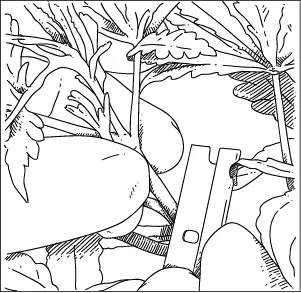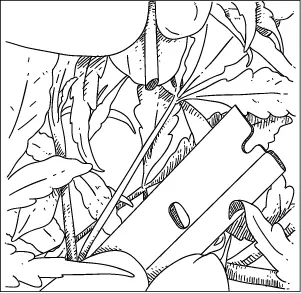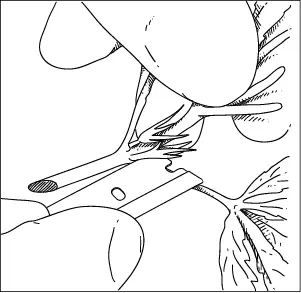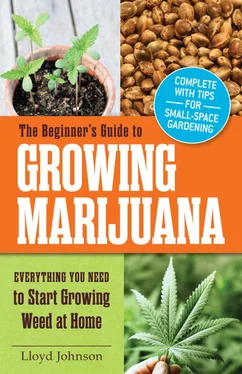If you are organic to the core and want to use a natural hormone booster, try willow water. Willow water has been shown to promote 20 percent more roots than using plain water. Use slim willow branches (approximately one inch in diameter), cut into short lengths and stripped of their leaves. Pack in a clean glass jar, fill with clean water to cover, and soak for twenty-four hours. Pour off the water into smaller jars and let your cuttings soak in willow water for another twenty-four hours, then plant in soil.
Clones perform better at rooting with a pH of 5.0 to 5.5. It is advisable to test the pH if you are planting the cuttings directly into soil or soil and compost mix.
The Cutting Procedure
In addition to the chosen mother plant(s), you will need:
• New, sharp, single-edge razor blades
• Rooting gel
• Alcohol (for sterilizing, not for you)
• Disposable gloves (optional)
• Sharpie pen
• Containers
• Soil or a growing medium like rooting cubes, well moistened
First, decide which females to take cuttings from, and flush the mother plant for three days, if needed. Make certain the mother is at least two months old. Look carefully at the plant and determine how many cuttings you want to take and how many the plant can give you; a lot depends on the actual size of your mother.
Next, spread out your tools and label the containers for the cuttings. It is best to do the labeling first, especially if you are taking cuttings from more than one mother plant during a session.
Make certain the growing medium is well moistened with a drill premade in the center of the pot or grow cube. You can use a pencil or your little finger, but prepare to accommodate the stem and two trimmed nodes. The drill, or hole, should stop about an inch to a half-inch from the bottom of your container.
Taking cuttings is like a little surgery for your plant; it is very important that everything be quite clean. Wash your hands with soap and hot water, and tools that will touch the cutting should be cleaned with alcohol. Many growers use disposable surgical gloves when they are taking cuttings, but washing your hands well should suffice.
Take the clean razor and make an angled cut on the chosen stem. Remember, you will be taking cuttings from the area close to the main stem or trunk, and near the base. You want a nice clean cut at a forty-five-degree angle, not a straight cut. Take three to four sets of leaves in a cut about four inches in length. Immediately place the cut ends in clean water until you are done taking cuttings.

Make an angled cut on the chosen stem.

Cut at a forty-five-degree angle.
Next you are going to trim off two sets of leaves and growth nodes nearest to the cut end of the stem while leaving the other two sets of leaves intact. Take your rooting gel and generously apply it to the cut end and all the way up to your trimmed nodes. The rooting gel immediately protects the cuttings and gives them what they need to reroot.

Trim off two sets of leaves and growth nodes nearest to the end of the stem.
Place the cutting gently into the prepared potting soil or rooting cubes. If you are using soil, fill in with a little soil and water in the cutting. If you are using root cubes, pinch the top of the cube to bring the stem into full contact with the cube.
Keep the cuttings at very high humidity (90 to 100 percent) for the first few days, and then gradually reduce to around 80 percent by the third or fourth day. Some growers use small humidity domes because the cuttings must be kept moist at all times. The domes save a lot of work, as they cut down on the amount of misting you would otherwise need to do. The remaining leaves need to be lightly misted with water for the plant to drink; remember, at this point the cutting has no roots at all and needs to foliar drink until it can grow some.
Clones will root in a small greenhouse, but experienced cloners advise giving eighteen to twenty-four hours of fluorescent light. The little cuttings’ leaves are doing all the work for the soon-to-be plant and cannot tolerate intense light. A cool, white light like fluorescent is best.
You can get your clones to root faster if you keep the soil or medium slightly warmer than the air temperature. Some growers use a heating mat, or raise the clone tray up higher and place a light bulb underneath for warmth.
The clones should perk up within a few days to a week. If they stay wilted after seven days, they are probably not going to make it. Sometimes you will have to cull these nonachievers, as leaving them wilting amongst the healthy clones can lead to disease. The cuttings that have rooted successfully should be ready to transplant in one to three weeks. Check to see if there is healthy-looking root growth from the grow cube or bottom of the little pot.
Once you have healthy white roots growing at least an inch and a half long from the cube, you can transplant your rooted clone and proceed with vegetative growth. Remember not to shock it by sudden exposure to bright and hot light (whether from the sun or grow lights); gradually lower the fluorescent lights to within a few inches of the clones to get them ready for more and hotter light.
CHAPTER 6
Cannabis in Containers
An outdoor container garden can be grown on a deck or interspersed with other cover/companion plantings within your regular garden. This can be one of the best ways to start off growing cannabis. It allows you to try growing without a large outlay in labor and materials, and allows easy moving of the plants as you learn how the sun moves around your property during the growing season.
If you are thinking of a small outdoor grow in containers, the first things to look at are how close your neighbors are and how accessible your deck or backyard garden is to passersby. Ideally, this area is fenced, with a locking gate.
Light
Another big factor in urban or suburban grows is the presence of artificial light. Do your neighbors have nighttime security lights or bright porch lights? Are there streetlights on all night? Cannabis’s flowering is triggered by light cycle, whether natural seasonal duration of the sunlight or by artificial light, so continuous nighttime light can be a problem.
Proximity to Schools
Check into the laws in your particular state; many legal medical growers have been dismayed to find out that growing (even indoors) within 1,000 feet of a school is a prohibited activity. This is something far better known ahead of time, as the legal implications can be very troublesome.
Potential Thieves
Even if you are growing legally on your own property, remember that your cannabis will be very attractive to thieves. The best way to protect your plants is to have them blend in to an existing container garden or a mix of containers and larger varied plants that are perennial, larger, and growing in the ground.
An array of different greens and leaf types (think of how camouflage works) makes it much harder for the nongardener to spot cannabis. Most cannabis thieves are not gardeners; that is why they are out stealing yours!
Читать дальше















